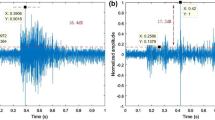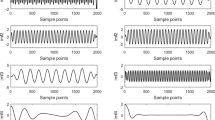Abstract
Empirical mode decomposition (EMD) is a recently proposed nonlinear and nonstationary laser signal denoising method. A noisy signal is broken down using EMD into oscillatory components that are called intrinsic mode functions (IMFs). Thresholding-based denoising and correlation-based partial reconstruction of IMFs are the two main research directions for EMD-based denoising. Similar to other decomposition-based denoising approaches, EMD-based denoising methods require a reliable threshold to determine which IMFs are noise components and which IMFs are noise-free components. In this work, we propose a new approach in which each IMF is first denoised using EMD interval thresholding (EMD-IT), and then a robust thresholding process based on Spearman correlation coefficient is used for relevant modes selection. The proposed method tackles the problem using a thresholding-based denoising approach coupled with partial reconstruction of the relevant IMFs. Other traditional denoising methods, including correlation-based EMD partial reconstruction (EMD-Correlation), discrete Fourier transform and wavelet-based methods, are investigated to provide a comparison with the proposed technique. Simulation and test results demonstrate the superior performance of the proposed method when compared with the other methods.















Similar content being viewed by others
References
Swinkels, B.L., Bhattacharya, N., Braat, J.J.M.: Correcting movement errors in frequency-sweeping interferometry. Opt. Lett. 30(17), 2242 (2005)
Cabral, A., Rebordao, J.: Accuracy of frequency-sweeping interferometry for absolute distance metrology. Opt. Eng. 46(7), 73602 (2007)
Donoho, D.L., Johostone, I.M.: Ideal spatial adaptation via wavelet shrinkage. Biometrika. 81(3), 425 (1994)
Donoho, D.: De-noising by soft-thresholding. IEEE Trans. Inf. Theory 41(3), 613 (1995)
Yan, R., Gao, R., Chen, X.F.: Wavelets for fault diagnosis of rotary machines: a review with applications. Signal Process 96, 1 (2014)
Huang, N.E., Huang, Z.S., Long, S.R., Wu, M.C., Zheng, S.Q., Yen, N.C., Tung, C.C., Liu, H.H.: The empirical mode decomposition and the Hilbert spectrum for nonlinear and non-stationary time series analysis. Proc. R. Soc. Lond. 454, 903 (1998)
Huang, N.E., Long, S.R., Shen, Z.: Frequency downshift in non-linear water wave evolution. Adv. Appl. Mech. 32, 59 (1996)
Huang, N.E.: The empirical mode decomposition and the Hilbert spectrum for nonlinear and non-stationary time series analysis. Proceedings of the Royal Society of London (1998)
Huang, N.E.: The Ages of Large Amplitude Coastal Seiches on the Caribbean Coast of Puerto Rico. Phys. Oceanogr. 30(8), 405 (2000)
Kopsinis, Y., McLaughlin, S.: Empirical mode decomposition based denoising techniques. 1st IAPR International Workshop on Cognitive Information Processing (CIP 2008)
Kopsinis, Y., Mclanglin, S.: Empirical mode decomposition based soft thresholding. In: Proceedings of the 16th European Signal Processing Conference (EUSIPCO 2008)
Kopsinis, Y., Mclanglin, S.: Development of EMD-based denoising methods inspired by wavelet thresholding. IEEE Trans. Signal Process 57(4), 1351 (2009)
Li, M., Li, H.J., Xiong, X.L.: A novel EMD selecting thresholding method based on multiple iteration for denoising LIDAR signal. Opt. Rev. 22, 477 (2015)
Wu, Z., Huang, N.E.: A study of the characteristics of white noise using the empirical mode decomposition method. Proc. R. Soc. Lond. 460(2046), 1597 (2004)
Boudraa, A.O., Cexus, J.C.: EMD-based signal filtering. IEEE Trans. Instrum. Meas. 56(6), 2196 (2007)
Peng, Z.K., Peter, W.T., Chu, F.L.: Comparison study of improved Hilbert-Huang transform and wavelet transform: Application to fault diagnosis for rolling bearing. Mech. Syst. Signal Process. 19(5), 974 (2005)
Ayenu-Prah, A., Attoh-Okine, N.: A criterion for selecting relevant intrinsic mode functions in empirical mode decomposition. Adv. Adapt. Data Anal. 2(1), 1 (2010)
Tang, Y.W., Tai, C.C., Su, C.C.: A correlated empirical mode decomposition method for partial discharge signal denoising. Meas. Sci. Technol. 21(8), 085 (2010)
Yang, G.L., Liu, Y.Y., Wang, Y.Y., Zhou, Z.L.: EMD interval thresholding denoising based on similarity measure to select relevant modes. Signal Process. 109, 95 (2015)
Komaty, A., Boudraa, A.O., Dare, D.: EMD-based filtering using the Hausdoff distance. Proceedings of IEEE International Symposium on Signal Processing and Information Technology (ISSPIT 2012)
Komaty, A., Boudraa, A.O., Augier, B., Dare-Emzivat, D.: EMD-based filtering using similarity measure between probability density functions of IMFs. IEEE Trans. Instrum. Meas. 63(1), 27–34 (2014)
Rilling, G., Flandrin, P.: One or two frequencies: the empirical mode decomposi-tion answers. IEEE Trans. Signal Process. 56, 85 (2008)
Mallat, S.: A Wavelet Tour of Signal Processing, 3rd edn: The Sparse Way. Academic Press, New York (1999)
Zhang, S.Y., Liu, Y.Y., Liu, Y.G.: EMD Iiterval thresholding denoising based on correlation coefficient to select relevant modes. Proceedings of the 34th Chinese Control Conference, 4801 (2015)
Lehman, A.: Jmp for Basic Univariate and Multivariate Statistics: A Step-by-Step Guide, p. 123. SAS Press, Cary (2005)
Myers, J.L., Well, A.D.: Research Design and Statistical Analysis, 2nd edn. Lawrence Erlbaum Associates, New Jersey (2003)
Author information
Authors and Affiliations
Corresponding author
Rights and permissions
About this article
Cite this article
Duan, Y., Song, C. Relevant modes selection method based on Spearman correlation coefficient for laser signal denoising using empirical mode decomposition. Opt Rev 23, 936–949 (2016). https://doi.org/10.1007/s10043-016-0275-x
Received:
Accepted:
Published:
Issue Date:
DOI: https://doi.org/10.1007/s10043-016-0275-x




